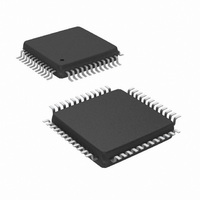LM4546BVHX/NOPB National Semiconductor, LM4546BVHX/NOPB Datasheet - Page 24

LM4546BVHX/NOPB
Manufacturer Part Number
LM4546BVHX/NOPB
Description
IC AUDIO CODEC 2MULTICH 48-LQFP
Manufacturer
National Semiconductor
Type
Audio Codec '97r
Datasheet
1.LM4546BVHXNOPB.pdf
(27 pages)
Specifications of LM4546BVHX/NOPB
Data Interface
Serial
Resolution (bits)
18 b
Number Of Adcs / Dacs
2 / 2
Sigma Delta
Yes
Dynamic Range, Adcs / Dacs (db) Typ
90 / 89
Voltage - Supply, Analog
4.2 V ~ 5.5 V
Voltage - Supply, Digital
3 V ~ 5.5 V
Operating Temperature
-40°C ~ 85°C
Mounting Type
Surface Mount
Package / Case
48-LQFP
Lead Free Status / RoHS Status
Lead free / RoHS Compliant
Other names
LM4546BVHX
Available stocks
Company
Part Number
Manufacturer
Quantity
Price
Company:
Part Number:
LM4546BVHX/NOPB
Manufacturer:
Texas Instruments
Quantity:
10 000
www.national.com
Low Power Modes
Improving System Performance
The audio codec is capable of dynamic range performance
in excess of 90 db., but the user must pay careful attention to
several factors to achieve this. A primary consideration is
keeping analog and digital grounds separate, and connect-
ing them together in only one place. Some designers show
the connection as a zero ohm resistor, which allows naming
the nets separately. Although it is possible to use a two layer
board, it is recommended that a minimum of four layers be
used, with the two inside layers being analog ground and
digital ground. If EMI is a system consideration, then as
many as eight layers have been successfully used. The 12
and 25 MHz. clocks can have significant harmonic content
depending on the rise and fall times. With the exception of
the digital VDD pins, (covered later) bypass capacitors
should be very close to the package. The analog VDD pins
should be supplied from a separate regulator to reduce
noise. By operating the digital portion on 3.3V instead of 5V,
an additional 0.5-0.7 db improvement can be obtained.
The bandgap reference and the anti-pop slow turn-on circuit
were improved in the LM4546B. A pullup resistor is not
required on V
resistor can be left on the pc board, but the temperature
coefficient will improve with no resistor on this pin. In addi-
tion, the THD will improve by 0.2–0.5 dB. The external
capacitor is charged by an internal current source, ramping
the voltage slowly. This results in slow turn-on of the audio
stages, eliminating “pops and clicks”. Thus, turn-on perfor-
mance is also improved. The pullup resistor, in conjunction
with the internal impedance and the external capacitor, form
a frequency dependent divider from the analog supply. Noise
on the analog supply will be coupled into the audio path, with
approximately 30 dB.of attenuation. Although this is not a
large amount if the noise on the supply is tens of millivolts, it
will prevent SNR from exceeding 80 dB.
In Figure 1 and Figure 2, the input coupling capacitors are
shown as 1 µF. capacitors. This is only necessary for extend-
ing the response down to 20 Hz. for music applications. For
telematics or voice applications, the lower 3 dB. can be
much higher. Using a guaranteed input resistance of 10 kΩ,
(40 kΩ typical), a 0.1 µF capacitor may be used. The lower 3
REF
, pin 27. For an existing design, the 10 kΩ
(Continued)
FIGURE 8. AC Link Powerdown Timing
24
dB point will still be below 300 Hz. By using a smaller
capacitor, the package size may be reduced, leading to a
lower system cost.
Backwards Compatibility
The LM4546B is improved compared to the LM4546A. If it is
required to build a board that will use either part, a 10 kΩ
resistor must be added from the V
the LM4546A. It is not required for the LM4546B. Addition of
this resistor will slightly increase the temperature coefficient
of the internal bandgap reference and slightly decrease the
THD performance, but overall performance will still be better
than the LM4546A.
The LM4546A requires that pins 1 and 9 (DV
directly to a 27 nH. inductor before going to the 3.3 Volt
digital supply and bypass capacitors. The inductor is not
required for the LM4546B and should not be used.
Multiple Codecs
EXTENDED AC LINK
Up to four codecs can be supported on the extended AC
Link. These multiple codec implementations should run off a
common BIT_CLK generated by the Primary Codec. All
codecs share the AC ’97 Digital Controller output signals,
SYNC, SDATA_OUT, and RESET#. Each codec, however,
supplies its own SDATA_IN signal back to the controller, with
the result that the controller requires one dedicated input pin
per codec (Figure 9).
By definition there can be one Primary Codec and up to
three Secondary Codecs on an extended AC Link. The
Primary Codec has a Codec Identity = (ID1, ID0) = ID = 00
while Secondary Codecs take identities equal to 01, 10 or
11. The Codec Identity is used as a chip select function. This
allows the Command and Status registers in any of the
codecs to be individually addressed although the access
mechanism for Secondary Codecs differs slightly from that
for a Primary.
REF
pin (pin 27) to AV
20123309
DD
) connect
DD
for









